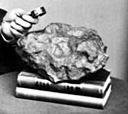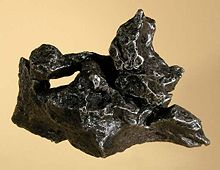AMAZING FACTS About METEORITE
A meteorite is a meteoroid (a solid piece of debris from such sources as asteroids or comets) originating in outer space that survives impact with the Earth's surface. A meteorite's size can range from small to extremely large. When a meteoroid enters the atmosphere, frictional, pressure, and chemical interactions with the atmospheric gases cause the body to heat up and emit light, thus forming a fireball, also known as a meteor or shooting/falling star. The term bolide refers to either an extraterrestrial body that collides with the Earth, or to an exceptionally bright, fireball-like meteor regardless of whether it ultimately impacts the surface.More generally, a meteorite on the surface of any celestial body is a natural object that has come from elsewhere in space. Meteorites have been found on the Moon[1][2] and Mars.[3] Meteorites that are recovered after being observed as they transited the atmosphere or impacted the Earth are called falls. All other meteorites are known as finds. As of February 2010, there are approximately 1,086 witnessed falls having specimens in the world's collections. In contrast, there are more than 38,660 well-documented meteorite finds.[4]Meteorites have traditionally been divided into three broad categories: stony meteorites are rocks, mainly composed of silicate minerals; iron meteorites are largely composed of metallic iron-nickel; and, stony-iron meteorites contain large amounts of both metallic and rocky material. Modern classification schemes divide meteorites into groups according to their structure, chemical and isotopic composition and mineralogy. Meteorites smaller than 2mm are classified as micrometeorites.
Fall phenomena
Most meteoroids disintegrate when entering Earth's atmosphere. Only 5 or 6 a year are typically recovered and made known to scientists. Few meteorites are large enough to create large impact craters. Instead, they typically arrive at the surface at their terminal velocity and, at most, create a small pit. Even so, falling meteorites have reportedly caused damage to property, and injuries to livestock and people.
Large meteoroids may strike the ground with a significant fraction of their cosmic velocity, leaving behind ahypervelocity impact crater. The kind of crater will depend on the size, composition, degree of fragmentation, and incoming angle of the impactor. The force of such collisions has the potential to cause widespread destruction.[6][7]The most frequent hypervelocity cratering events on the Earth are caused by iron meteoroids, which are most easily able to transit the atmosphere intact. Examples of craters caused by iron meteoroids include Barringer Meteor Crater, Odessa Meteor Crater, Wabar craters, and Wolfe Creek crater; iron meteorites are found in association with all of these craters. In contrast, even relatively large stony or icy bodies like small comets or asteroids, up to millions of tons, are disrupted in the atmosphere, and do not make impact craters.[8] Although such disruption events are uncommon, they can cause a considerable concussion to occur; the famed Tunguska event probably resulted from such an incident. Very large stony objects, hundreds of meters in diameter or more, weighing tens of millions of tons or more, can reach the surface and cause large craters, but are very rare. Such events are generally so energetic that the impactor is completely destroyed, leaving no meteorites. (The very first example of a stony meteorite found in association with a large impact crater, the Morokweng crater in South Africa, was reported in May 2006.[9])
Several phenomena are well documented during witnessed meteorite falls too small to produce hypervelocity craters.[10] The fireball that occurs as the meteoroid passes through the atmosphere can appear to be very bright, rivaling the sun in intensity, although most are far dimmer and may not even be noticed during daytime. Various colors have been reported, including yellow, green, and red. Flashes and bursts of light can occur as the object breaks up. Explosions, detonations, and rumblings are often heard during meteorite falls, which can be caused by sonic booms as well as shock waves resulting from major fragmentation events. These sounds can be heard over wide areas, up to many thousands of square km. Whistling and hissing sounds are also sometimes heard, but are poorly understood. Following passage of the fireball, it is not unusual for a dust trail to linger in the atmosphere for some time.
As meteoroids are heated during atmospheric entry, their surfaces melt and experience ablation. They can be sculpted into various shapes during this process, sometimes resulting in deep "thumb-print" like indentations on their surfaces called regmaglypts. If the meteoroid maintains a fixed orientation for some time, without tumbling, it may develop a conical "nose cone" or "heat shield" shape. As it decelerates, eventually the molten surface layer solidifies into a thin fusion crust, which on most meteorites is black (on some achondrites, the fusion crust may be very light colored). On stony meteorites, the heat-affected zone is at most a few mm deep; in iron meteorites, which are more thermally conductive, the structure of the metal may be affected by heat up to 1 centimetre (0.39 in) below the surface. Meteorites are sometimes reported to be warm to the touch when they land, but they are never hot. Reports, however, vary greatly, with some meteorites being reported as "burning hot to the touch" upon landing,[11][12] and others forming a frost upon their surface.[13]
Meteoroids that experience disruption in the atmosphere may fall as meteorite showers, which can range from only a few up to thousands of separate individuals. The area over which a meteorite shower falls is known as its strewn field. Strewn fields are commonly elliptical in shape, with the major axis parallel to the direction of flight. In most cases, the largest meteorites in a shower are found farthest down-range in the strewn field.
SOURCE: WIKIPEDIA


No comments:
Post a Comment